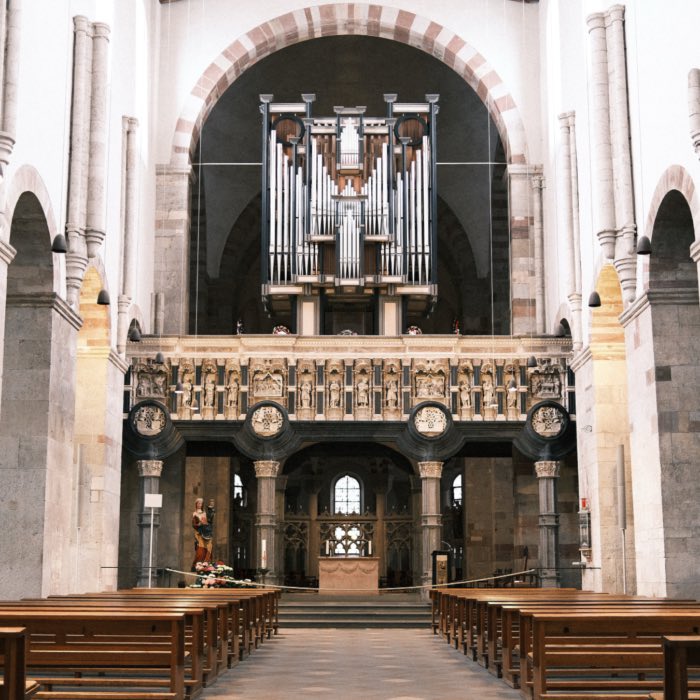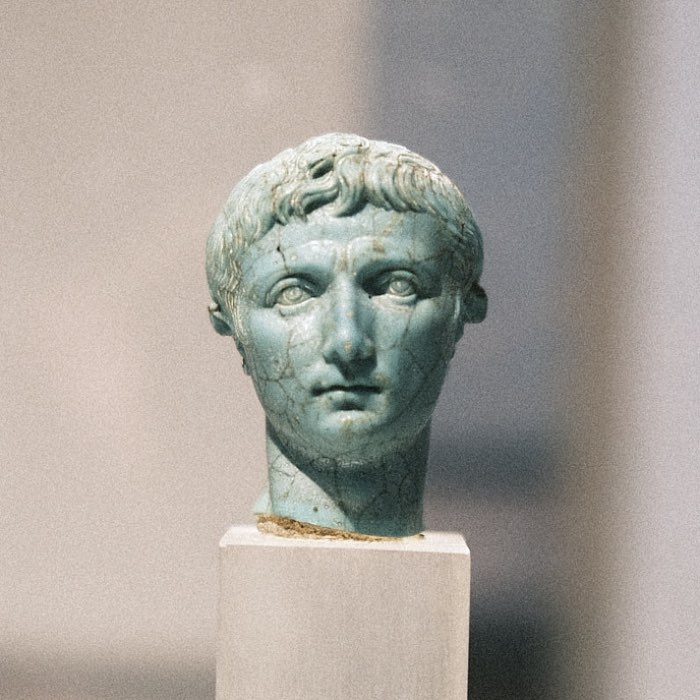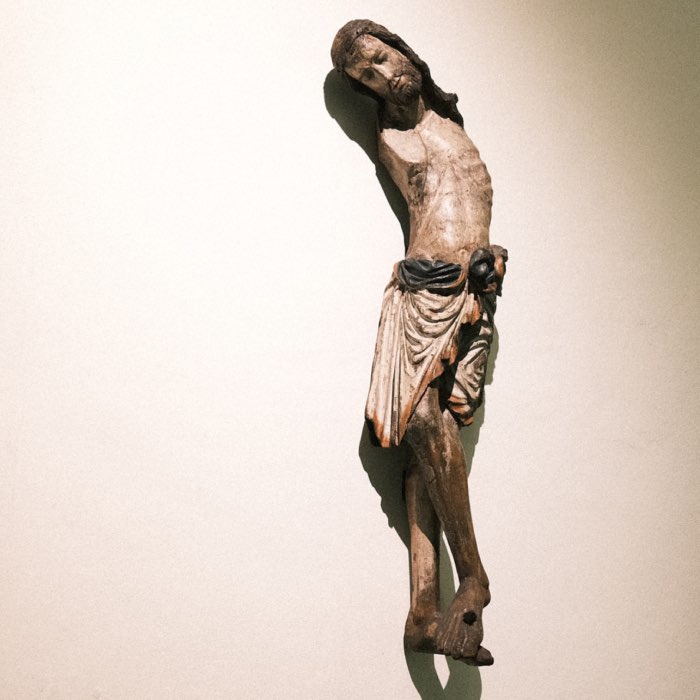From Roman temple to Christian sanctuary: The historical evolution of St. Maria im Kapitol in Cologne
Standing proudly amidst the historic cityscape of Cologne, St. Maria im Kapitol is more than just a place of worship. It’s a witness to the layers of history that have shaped the city over centuries. At its core lies a rich narrative that traces back to ancient Roman times, where a temple once dedicated to the Capitoline Triad stood. The history of this temple exemplifies how ancient buildings were not simply erased but repurposed and altered over time. It illustrates that the ancient world did not vanish overnight. Instead, it was transformed and integrated into the medieval and modern eras, challenging the image of sharp epochal changes and highlighting a continuous development of cultural and architectural heritage.
 Model of the Roman Capitolium in Cologne. The temple was dedicated to the Capitoline Triad, comprising the three most revered deities in Roman religion: Jupiter, Juno, and Minerva.
Model of the Roman Capitolium in Cologne. The temple was dedicated to the Capitoline Triad, comprising the three most revered deities in Roman religion: Jupiter, Juno, and Minerva.
 Today’s St. Maria im Kapitol. The church was built on the foundations of the Roman Capitolium. Here, we see the three-conch complex and the sculpture ‘Die Trauernde’ (‘The mourner’) placed in the courtyard of the church.
Today’s St. Maria im Kapitol. The church was built on the foundations of the Roman Capitolium. Here, we see the three-conch complex and the sculpture ‘Die Trauernde’ (‘The mourner’) placed in the courtyard of the church.
The Roman origins
The story begins in the 1st century CE when Cologne, then known as Colonia Claudia Ara Agrippinensium (CCAA), was a Roman colony situated on the banks of the Rhine River. At the heart of the city stood a grand temple dedicated to the Capitoline Triad, Jupiter, Juno, and Minerva, the most revered deities in Roman religion. This temple, like many others across the Roman Empire, served as a focal point for religious worship and civic life. Unlike typical Roman temples, which were situated in the city’s forum, this temple was uniquely positioned above the Rhine and adjacent to the city walls.
 Animation of Cologne in the 2nd and 3rd centuries. The Forum is in the center and the Capitolium is visible on the left side. The animation was shown at the Römisch-Germanisches Museum in Cologne.
Animation of Cologne in the 2nd and 3rd centuries. The Forum is in the center and the Capitolium is visible on the left side. The animation was shown at the Römisch-Germanisches Museum in Cologne.
The temple itself was accessible via an eastern staircase facing the Rhine and rested on a podium that was 4.4 meters high, measuring 33 by 29.5 meters. The enclosed sacred area, or temenos, was considerably larger, spanning approximately 94 to 97 meters by 69 meters, primarily bordered by a robust 5.5-meter-high western wall that now forms part of the cloister on the eastern side of the today’s church structure. The temple was constructed with deep foundations and divided internally into three cellae, each housing an image of one of the triad gods. An open-columned porch in Corinthian order graced the east side, the remains of which underpin the existing nave of the church.
 Model of the Roman Capitolium.
Model of the Roman Capitolium.
Early Middle Ages
The temple’s story evolved dramatically in the mid-5th century when the Franks conquered Cologne. The area, particularly the walled temple precinct, transitioned to the possession of Frankish kings and their vassals. By the late 7th century, the Frankish mayors of the palace had established their residence in Cologne on this very site. Among them was Pippin the Middle, who, after consolidating his power across various Frankish realms in 687, made Cologne a key seat of his authority. His wife Plektrudis founded a church dedicated to St. Mary on the remnants of the Capitolium towards the end of her life. This initial structure likely took the form of an elongated hall church with a rectangular layout of approximately 10 by 32 meters, utilizing parts of the old temple, including transforming the eastern colonnade into walls and shifting the entrance to the west. The side cellae may have served as side aisles, and the former porch was converted into a sanctuary with the main altar.
 Floor plan of the Roman temple with inscribed floor plan of the Salian church. Reconstruction by Bernhard Irmler, 2007. Source: Exhibition panels inside the church from the Förderverein Romanische Kirchen Köln.
Floor plan of the Roman temple with inscribed floor plan of the Salian church. Reconstruction by Bernhard Irmler, 2007. Source: Exhibition panels inside the church from the Förderverein Romanische Kirchen Köln.
 Sarcophagus of Plektrudis, wife of Pipin the Middle, founded the first church on the site of the Roman temple in the 7th century. The sarcophagus can still be seen in the church today. The elaborated tomb slab is more recent and dates from around 1160.
Sarcophagus of Plektrudis, wife of Pipin the Middle, founded the first church on the site of the Roman temple in the 7th century. The sarcophagus can still be seen in the church today. The elaborated tomb slab is more recent and dates from around 1160.
High and Late Middle Ages
The site witnessed further significant architectural evolution during the high and late Middle Ages. By the early Carolingian period (8th-9th century), a westwork with three towers was added. The catastrophic raid by Normans in the winter of 881/882 reportedly led to the burning of the church, although no archaeological evidence of this destruction has surfaced to date.
By the mid-10th century, the church experienced a shift in its clerical administration, with Archbishop Bruno relocating clerics to St. Andreas and introducing Benedictine nuns from the Remiremont Abbey. In the mid-11th century, Archbishop Hermann II and his sister, Ida, abbess of the attached female convent, initiated the construction of a new church designed as a cross basilica. This basilica featured a tri-conch layout around a towerless crossing and was characterized by round-arched barrel vaults in the aisles and flat coverings elsewhere. The church, reusing the Roman temple’s foundations and stones, was consecrated by Pope Leo IX in 1049 in the presence of Emperor Henry III, with the final consecration performed by Archbishop Anno II in 1065.

 The Little Three Kings Gate (Dreikönigenpförtchen) at St. Maria im Kapitol. The gate marks the entrance to the ‘Lichthof’ (courtyard) of the todays’s church and holds the statues of the Three Magi (copies; the original ones are today at Museum Schnütgen). According to legend, the relics of the Magi had arrived right here at the basilica in 1164, before they were transferred to the Cologne Cathedral where they are kept today.
The Little Three Kings Gate (Dreikönigenpförtchen) at St. Maria im Kapitol. The gate marks the entrance to the ‘Lichthof’ (courtyard) of the todays’s church and holds the statues of the Three Magi (copies; the original ones are today at Museum Schnütgen). According to legend, the relics of the Magi had arrived right here at the basilica in 1164, before they were transferred to the Cologne Cathedral where they are kept today.
Modern times
Over the centuries, St. Maria im Kapitol endured multiple restorations and modifications, particularly in response to the devastations of World War II. Post-war rebuilding efforts largely restored the church based on its 1150 state, though some Gothic chapels and the southern porch were preserved. The church was partially reopened in 1956 and fully by 1984, with significant reconstructions such as the late Gothic screens of the eastern conch being restored in the early 1980s.
 Destruction during the Second Wolrd War: The Dreikonchenchor from the south-east, 1946. Photo: conservator. Source: Exhibition panels inside the church from the Förderverein Romanische Kirchen Köln.
Destruction during the Second Wolrd War: The Dreikonchenchor from the south-east, 1946. Photo: conservator. Source: Exhibition panels inside the church from the Förderverein Romanische Kirchen Köln.
 Destruction during the Second Wolrd War: View from the west, 1946 (left) and the east conch with destroyed vault of the crypt, 1947 (right). Photo: Conservator. Source: Exhibition panels inside the church from the Förderverein Romanische Kirchen Köln.
Destruction during the Second Wolrd War: View from the west, 1946 (left) and the east conch with destroyed vault of the crypt, 1947 (right). Photo: Conservator. Source: Exhibition panels inside the church from the Förderverein Romanische Kirchen Köln.
 West side of the church as it is today.
West side of the church as it is today.
Historical significance of the church
St. Maria im Kapitol played a prominent role in Cologne. It was the main church after the cathedral. The archbishop always celebrated the first Christmas mass in St. Maria im Kapitol, the second in St. Cäcilien and the third in the cathedral. The council also marched from St. Mary’s to the cathedral on Epiphany in the procession in honour of the Three Kings, Cologne’s city saints. The official church ceremonies of the council and the exequies for archbishops, emperors and mayors often took place here. The town’s bell for storm and fire, known as the Bramglocke, was rung here. It was also the place where the relics of the Three Magi arrived in 1164 before they were transferred to the Cologne Cathedral where they are kept today.
Further impressions of the church
Here are some more impressions of the interior of the today’s church:
 Nave with six-part ribbed vaults. Above the altar, the Renaissance rood screen is visible. This rood screen is the earliest Renaissance work in Cologne. It was commissioned by five Cologne patrician families in Mechelen in 1517-23. Today, it supports the organ.
Nave with six-part ribbed vaults. Above the altar, the Renaissance rood screen is visible. This rood screen is the earliest Renaissance work in Cologne. It was commissioned by five Cologne patrician families in Mechelen in 1517-23. Today, it supports the organ.
 Floor mosaic at the entrance to the central nave.
Floor mosaic at the entrance to the central nave.
 Detail of the rood screen.
Detail of the rood screen.
 Another sarcophagus in the back of the church.
Another sarcophagus in the back of the church.
 Jesus statue.
Jesus statue.
 Mosaics on an altar beneath the forked cross.
Mosaics on an altar beneath the forked cross.
 Floor mosaics in front of the altar beneath the forked cross.
Floor mosaics in front of the altar beneath the forked cross.
 St. Maria im Kapitol, Entombment of Christ (16th century).
St. Maria im Kapitol, Entombment of Christ (16th century).
 Old reliefs carved into the walls of the cloister. Unfortunately, there are no signs on them, so I can’t give any further details.
Old reliefs carved into the walls of the cloister. Unfortunately, there are no signs on them, so I can’t give any further details.
 Old reliefs carved into the walls of the cloister. Unfortunately, there are no signs on them, so I can’t give any further details.
Old reliefs carved into the walls of the cloister. Unfortunately, there are no signs on them, so I can’t give any further details.
 Old reliefs carved into the walls of the cloister. Unfortunately, there are no signs on them, so I can’t give any further details.
Old reliefs carved into the walls of the cloister. Unfortunately, there are no signs on them, so I can’t give any further details.
Conclusion
The evolution of St. Maria im Kapitol from a Roman temple to a Christian sanctuary exemplarily demonstrates what happened to many ancient buildings in the course of history. Either they were irretrievably destroyed, repurposed as quarries, or adapted to new prophane or religious contexts and altered other he centuries. The example of this former Roman sacred building in particular shows how the new religion, the emerging Christianity, displaced the old religions. It either destroyed or censored evidence of the old religions, or transferred their remnants, both architectural and intellectual, to a new function, serving the new religion and often obscuring any reference to their actual origin. This is typical of Christianity, which adopted many elements of the ancient, in its view pagan, traditions and integrated them into its own Jewish roots in order to invent itself as a new religion and create unique selling points.
Nevertheless, St. Maria im Kapitol is a remarkable place of continuous religious practice and worship throughout the centuries. It stands, among many other places, as an important ground connecting our present to the past, reminding us of the complex layers of history which, layer by layer, shape the world we live in today. It is a place where the past is not forgotten but preserved and integrated into the present, enriching our understanding of the world and, thus, the future we are going to shape.
References and further reading
- Wikipedia article on St. Maria im Kapitolꜛ
- Website of St. Maria im Kapitolꜛ
- Exhibition panels inside the church from the Förderverein Romanische Kirchen Kölnꜛ
- Marcus Trier, Friederike Naumann-Steckner, 14 CE - Römische Herrschaft am Rhein, 2014, Wienand, ISBN: 9783868322262
- Jürgen Kaiser, Florian Monheim, Die großen romanischen Kirchen in Köln, 2017, Greven Verlag, ISBN: 9783774306875
















































comments